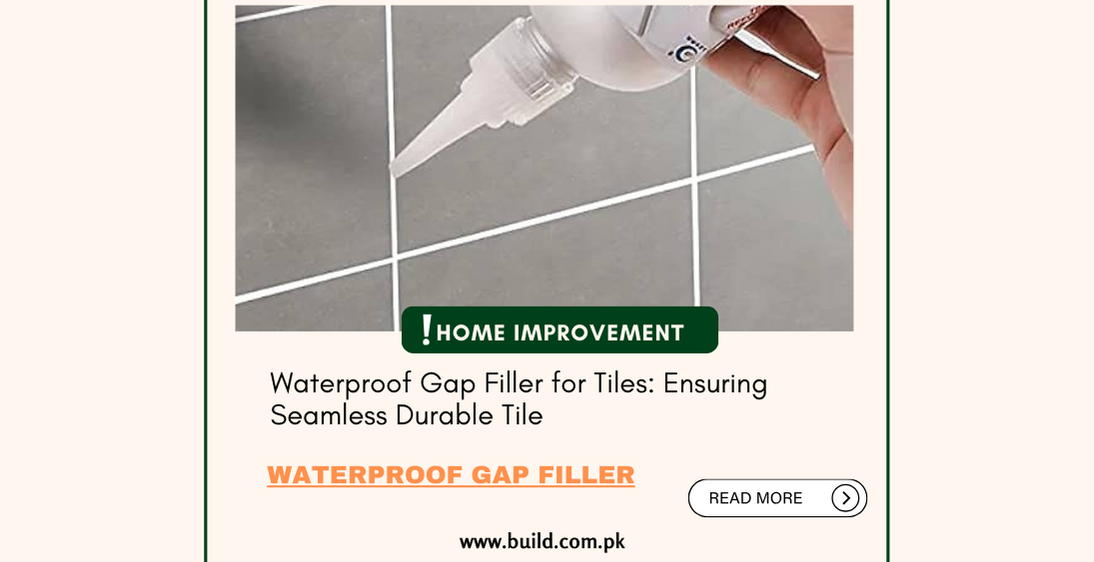Waterproof Gap Filler for Tiles: Ensuring Seamless Durable Tile

Introduction:
When it comes to tile installations, achieving a seamless and
waterproof finish is essential for long-term durability and aesthetic appeal.
In this comprehensive guide, we delve into the world of waterproof gap filler
for tiles, exploring its importance, types, application techniques, and top
recommendations. Whether you're renovating your bathroom, kitchen, or outdoor
space, understanding the nuances of waterproof gap filler is crucial for
ensuring a flawless and lasting tile installation. Let's dive into the details
and unravel the secrets to achieving water-tight tile joints with the right gap
filler.
Understanding Waterproof Gap Filler for Tiles:
Waterproof gap filler, also known as tile grout or caulking,
is a specialized materia used to fill gaps and joints between tiles, ensuring
a watertight seal and preventing moisture penetration. Unlike traditional
grout, waterproof gap filler is designed to withstand water exposure and resist
mold, mildew, and staining, making it ideal for areas prone to moisture such as
bathrooms, kitchens, and outdoor spaces.

Types of Waterproof Gap Filler
Epoxy Grout:
Epoxy grout is a durable and waterproof option
that consists of epoxy resins and hardeners. It offers superior stain
resistance, color consistency, and durability compared to cement-based grouts,
making it ideal for high-moisture areas and heavy-traffic spaces.
Silicone Caulk:
Silicone caulk is a flexible and waterproof
sealant commonly used for filling gaps and joints between tiles, countertops,
and fixtures. It provides excellent adhesion, flexibility, and resistance to
water, making it suitable for both interior and exterior tile installations.
Polyurethane Sealant:
Polyurethane sealant is a versatile and
durable sealant that offers excellent adhesion, flexibility, and waterproofing
properties. It is commonly used for sealing expansion joints, cracks, and gaps
in tile installations, providing long-lasting protection against water
intrusion and moisture damage.
Application Techniques for Waterproof Gap Filler
Preparation:
Ensure that the tile joints are clean, dry, and
free of any debris or residues before applying the waterproof gap filler. Use a
brush or vacuum to remove any loose particles or dust from the joints.
Application:
Apply the waterproof gap filler using a caulking
gun or grout float, filling the joints evenly and ensuring full coverage. Use a
smooth, steady motion to apply the filler, avoiding overfilling or gaps in the
joints.
Tooling:
After applying the filler, use a damp sponge or
finger to smooth and tool the joints, removing any excess filler and ensuring a
uniform finish. Take care to wipe away any excess filler from the tile surfaces
before it dries to avoid staining or residue buildup.
Curing:
Allow the waterproof gap filler to cure completely according
to the manufacturer's instructions before exposing it to water or heavy
traffic. This typically involves a curing period of 24 to 48 hours, depending
on the type of filler and environmental conditions.
Top Recommendations for Waterproof Gap Filler
Laticrete SpectraLOCK PRO Epoxy Grout: This premium epoxy
grout offers exceptional durability, stain resistance, and waterproofing
properties, making it ideal for high-moisture areas and heavy-traffic spaces.
DAP Dynaflex Ultra Silicone Caulk: This high-performance
silicone caulk provides superior adhesion, flexibility, and waterproofing
properties, making it suitable for both interior and exterior tile
installations.
SikaFlex-1a Polyurethane Sealant: This versatile polyurethane
sealant offers excellent adhesion, flexibility, and waterproofing properties,
making it ideal for sealing expansion joints, cracks, and gaps in tile
installations.
Conclusion:
In conclusion, waterproof gap filler plays a crucial role in ensuring a seamless and durable tile installation by filling gaps and joints and providing a watertight seal. By understanding the types of waterproof gap filler available, application techniques, and top recommendations, you can achieve water-tight tile joints that withstand moisture exposure and provide long-lasting protection against water intru sion and damage. Whether you're renovating your bathroom, kitchen, or outdoor space, investing in quality waterproof gap filler is essential for achieving a flawless and lasting tile installation that enhances the beauty and functionality of your space.









